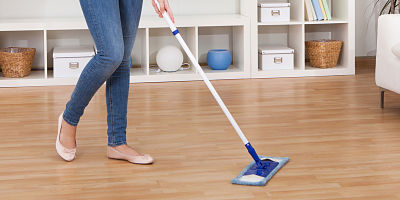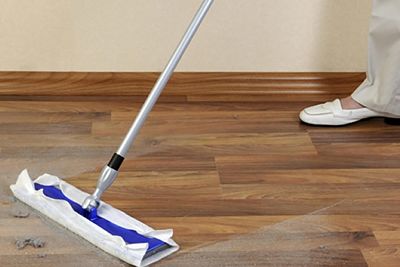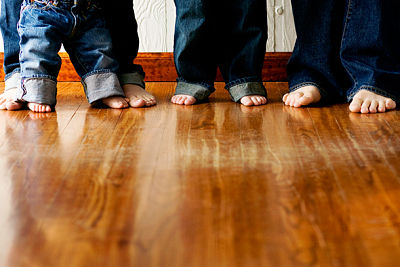
While laminate floors may look sturdy and scratch resistant, solid materials such as dust and debris can cause unappealing scratches on the surface over time. Additionally, using harsh detergents or chemicals to try to remove stubborn stains from the floor can result in streaks, if not damage the laminate downright.
Unlike most flooring materials, you won’t be able to refinish the scratched surface. Once something is off, pricey replacements may be your only option.
For this reason and more, the right cleaning routine is quite essential in ensuring that your floor retains its aesthetics while keeping you from having to shoulder huge additional costs. This routine involves choosing the right cleaners and tools as well as observing some simple steps that ensure dirt and debris do not stay on the surface of your laminate floor to damage it.
Page Contents [show]
Remove everyday dust by regular sweeping
Build up of dust on your laminate floor will mean that the solid material rubs against the surface as people use the space. This can set up your floor for some serious scratching and damage as solid matter such as grit can scratch the laminate flooring when underfoot, making it lose its protective sheen.
The good news is, you can avoid the damage by sweeping the floor every two to three days to remove everyday dirt. Of course, the frequency of sweeping will vary depending on how often the room is used.
Tools to use
- A dry microfiber laminate mop
Given the glossy surface of a laminate floor, a traditional brush or broom simply wouldn’t cut it as far as the sweeping is concerned. You don’t want the stiff bristles of a regular brush to damage the surface. A broom on the other hand, while might not scratch the laminate, will often lift any allergens on the floor into the air only for them to resettle right back.
So, what you’ll be doing is dry mopping, which involves sweeping the dry microfiber dust mop across the floor. Here, a flat-head microfiber mop is boss. It keeps moisture out and is especially going be perfect at that point when you start using a spray product for a more thorough cleaning. Check out this review we did on mops for laminate flooring.
- A vacuum with a soft brush attached to it
This is the other suitable tool you could use in place of a simple dry mop. It is the perfect tool for removing allergens which it easily traps from the floor. We even did a review of the best vacuums for laminate flooring here.
While vacuuming, it’s important that you follow the direction in which the laminate tiles were laid so that the tool can pick up any fragments resting in between the grooves.
Remove Stubborn Dirt Using Warm Water or Mild Cleaners
While a more thorough cleaning for most floors normally means mopping with water and detergents, the same cannot apply for a laminate floor. Water can seep into the layers of the laminate and cause warping and damage. With this kind of floor, all you need is a slightly damp rag, microfiber cloth or flattop mop.
How To Actually Do It

Add a generous amount of slightly hot (lukewarm) water in a bucket. The hot water ensures that streaks won’t remain on the laminate flooring after cleaning it. While you need hot water for this purpose, you don’t want to make it too hot either. Warm is just good enough for removing the stubborn dirt without damaging the protective laminate coating.
With your hot water ready, soak the microfiber cloth, mop or sponge in it, wring it out to remove the excess water and use the mildly damp piece of clothing to give the floor a thorough mopping, end to end.
A regular mop attached to a handle could work too, but this is harder to wring effectively, unlike the sponge mop.
Being barely damp, the sponge will be losing its moisture as you go. Depending on the size of the floor space you’re cleaning, you’ll need to repeat the soaking and wringing of your sponge to keep it damp throughout the mopping activity.
Ideally, the laminate floor should dry out by itself once you finish mopping with the damp sponge. Still, it helps to ensure the place is fairly dry before you quit the cleaning process. To dry the flooring, you could use a clean, dry, microfiber cloth to wipe it dry.
It is imperative that your choice of drying cloth is soft, an abrasive one may scratch the glossy surface.
Cleaners to Use When Mopping Laminate Flooring
While simple dirt should be easy to remove using hot water, some stains especially greasy ones will require a bit more help. Laminate flooring requires special care, so you won’t be using regular soap or your usual detergent as these may damage the protective sheen that you probably love a lot.
To clean laminate flooring, you have to use a properly formulated laminate floor cleaner to get the job done right. The detergent market has quite a few varieties of cleaners designed explicitly for laminate floors. These typically come in spray bottles and are available at home centers or flooring stores.
You should also be able to get some cheap but effective options on Amazon. Alternatively, you could use some readily available materials to prepare your own homemade laminate cleaner.
Now, there are those who believe that retail laminate cleaning solutions are likely to do a better job than your home-made solution. But then, you might get a different assessment if you try them both, so here are both, so you may go for what works better for you.
First off, a few cheap retail laminate cleaners that you may buy on Amazon or from your detergent shops.
Designed to be a leader in cleaning all floors, Black Diamond makes a strong case as far as professional cleaners go. The manufacturer has been making floor cleaning products for decades and has some great consumer ratings to its name, which likely speaks volumes regarding the quality of the cleaner.
Most users say the detergent works extremely well. It is fairly easy to use and leaves no streaks on your laminate flooring, so it would be worth a try.
If Black Diamond doesn’t fit the bill for whatever reason, you may want to give Bruce No-Wax cleaner a try. It’s another great option with some really appealing customer feedback for its effectiveness in cleaning urethane finished floors. You can use it to clean your laminate flooring regularly without any problems.
If you have pets, dogs in particular, then Bruce No-Wax cleaner may be your best friend. It’s quite effective in getting rid of the very stubborn spots that remain behind from your pet’s drool. A dog’s drool in particular can be stubborn and using just any of your household cleaners won’t always guarantee getting rid of the thing completely. But Bruce often gets the job done, so you may want to try it out.
Another way to keep the shine on your laminate flooring for longer is to use Bona laminate floor cleaner. The cleaner is safe to use and quite effective in removing stubborn stains from the laminate floor.
It has a unique de-greasing formulation that should be effective in removing just about any dirt, grime or dust; making your laminate floor looking sparkling clean.
You may also be interested to know that Bona laminate cleaner is a GREENGUARD Green certified products, so it is proven to be eco-friendly and safe for use in your home and around your family.
Here’s the last professional cleaner in our list that you are likely to love. Simply spray Zep commercial hardwood & laminate floor cleaner and mop away dirt, food and pet stains off your laminate floor without having to scrub or rinse.
With its mild detergent formulation, Zep also works great with spray mops, so we’d recommend trying both regular microfiber mops and spray mops to see what works best for you. Whichever way you go, using Zep commercial laminate cleaner means that no streaks or residue will remain behind.
DIY Homemade Cleaners For Laminate Flooring
Using regular cleaning products on laminate floors is discouraged as they can leave residue and streaks on the surface, if not damage the protective sealant of the laminate floor. This is why it’s important to always use only laminate approved cleaners on your floor.
For a cheaper option, you can swap commercial laminate cleaners for homemade options. When using either option, you should spray it sparingly on the floor before wiping with a suitable microfiber cloth or just apply it to the microfiber cloth or mop rather than directly to the laminate flooring.
There’s another consideration. If there’s a member of the family who suffers from asthma or allergies then some of these commercial cleaners may be a non-option for you.
If you elect to skip commercial laminate floor cleaners for whatever reason, then here are a few recipes for preparing your DIY homemade cleaners.
- Warm water and vinegar
A mix of warm water and vinegar is a superior homemade option for most flooring types, laminate floors included. It is top on the list of DIY options that will not damage your floor and instead protect and keep its shine for years. Not to mention that vinegar is eco-friendly and perfect for use in your home and around your family.
To prepare this cleaner, you’ll need:
- Hot water (2 cups or more depending on your needs)
- Vinegar (2 cups or more depending on your needs)
- Essential oil(s) of your choice (5-10 drops will be good)
- A spray bottle (right size) or mop bucket
Once you have your ingredients in the proportions indicated (equal parts), proceed to mix the hot water and vinegar in a spray bottle or mop bucket.
Vinegar is acidic and rather abrasive by itself. Diluting it ensures that it can safely remove mud or stubborn stains on your floor while protecting and preserving its beautiful sheen.
- Water, alcohol and vinegar
This recipe is the other option that’s perfect for any laminate flooring. To prepare the cleaner, you’ll need:
- Distilled water (1/2 cup)
- Rubbing alcohol (1/2 cup) for quick drying and stronger cleaning power
- Distilled white vinegar (1/2 cup)
- Essential oil (5 drops; preferably orange, lemon or lemon eucalyptus)
- Liquid dishwashing detergent (3 – 4 drops)
- Spray bottle
Add the ingredients in a large spray bottle and mix. This cleaner is especially great for getting rid of dried on dirt or cleaning sticky spots on the laminate surface.
- Baby shampoo and water
While standard adult shampoos, dyed or scented dish detergents are often likely to create streaks and cause damage to the laminate when used on these floors, a baby shampoo on the other hand is mildly formulated to be gentle.
As such, you can comfortably use it on laminate floors. Just add a small amount of the soap in water and mix with your hand until bubbles begin to form as the soap dissolves.
If you’re looking for a recommendation, try this Puracy Natural Baby Shampoo from Amazon.
Cleaning the Floor With Your Homemade Solution
There’s not much difference cleaning your floor with a commercial product or homemade solution. In both cases, you’ll use the spray bottle to apply the cleaner to the surface of the laminate floor a little a time; or apply it to the dry microfiber mop sparingly and use the mop to wipe the floor.
Remember to not spray the entire floor with the cleaner at once. The solution is fairly light so you need to wipe it off the floor almost immediately. Applying it to small sections of the floor and wiping as you go is therefore the right method.
Just like most laminate cleaners, using the homemade solution won’t necessarily require you to dry the floor after cleaning. However, you could do it out of preference or if there is some noticeable dampness on the cleaned floor. The idea is to avoid letting moisture sit on the laminate flooring for too long as this could cause it to warp.
Tips To Watch Out For

Hands down, the best way to maintain the sheen of your laminate flooring and ensure that it remains as good as new for as many years as you desire is to be proactive with its maintenance. Instead of waiting to address problems such as haze on your floor, it helps to prevent them from forming in the first place.
One way to see to this is to use laminate approved products only. That’s the only way to prevent haze from forming on this type of floor. Though they’re usually stubborn, you could remove haze from the floor by spraying a suitable laminate cleaner on the haze and gently working it with a good microfiber mop. Unfortunately, some damage might have been done already.
- Skip the fabric softener. Clean your mops frequently but while at it, don’t use fabric softener as this may just bring haze to your floor even when you use laminate approved products with the affected mop thereafter.
- Clean up spills immediately they happen. Letting any liquid sit on the laminate floor is one of the quickest ways to damage laminate flooring. So, in case of a spill, use a flat-head microfiber mop, sponge or cloth to clean up the liquid spills as soon as they happen.
- Think ahead and protect the floor from getting dirty or damaged in the first place. This means using furniture pads or felt floor protectors on furniture – especially those that get moved frequently. You’ll also need to keep those stilettos off your laminate flooring, have a good front door mat system (outdoor and indoor mats), and consider having a no-shoe-indoors policy.
- Steer clear of waxes and polishes. Of course, a laminate floor does not need to be waxed, polished or refinished. It’s generally designed to be durable, so as long as you take proper care of it, it will look beautiful and shiny for ages.
- Since laminate floors are susceptible to scratches which can be quite unsightly, you’ll want to stick to using a dust mop or soft-bristle broom to sweep up debris. With regards to vacuuming, always be keen on using an attachment that has no rotating brush or beater bar. These could scratch the surface of your floor.
- Do not use bleach on the floor. Bleach can soak in the laminate (it’s fairly porous), especially through the grooves and this can cause any number of problems including eroding the protective shiny finish and changing the color of the floor.
Strategies For Removing Stubborn Stains Like Nail Polish and Wine
Even if you’re careful, stains such as wine, ink, tar nail polish or shoe polish can still often find their way onto your floor – so it helps to be prepared for them.
To remove such stubborn stains, apply a small amount of nail polish remover or rubbing alcohol on a small sponge, microfiber cloth or cotton ball and use the damp material to scrub the stain off the laminate floor until it comes off.
Afterwards, wipe over the area with a damp microfiber cloth (soaked in clean water and wringed to be mildly soggy).
Blood stains on the other hand should come out if you clean them with window cleaner. Simply spray a little amount of the cleaner on the blood stain and wipe it away with a mildly damp cloth (dampened with warm water).
For candle wax or chewing gum, cover it in ice (could put the ice in a plastic bag) then scrape off gently with a plastic knife or credit card as soon as it has hardened.
In case there are scuff or heel marks left on the laminate flooring, you could get rid of them easily by using a pencil eraser.
Conclusion
There are literally thousands of different styles and makes of laminate flooring available on the market today. Regardless of which type you have in your home, the tips and tricks shared in this write-up are tried and tested and will help keep your laminate flooring in showroom shape if followed properly.

